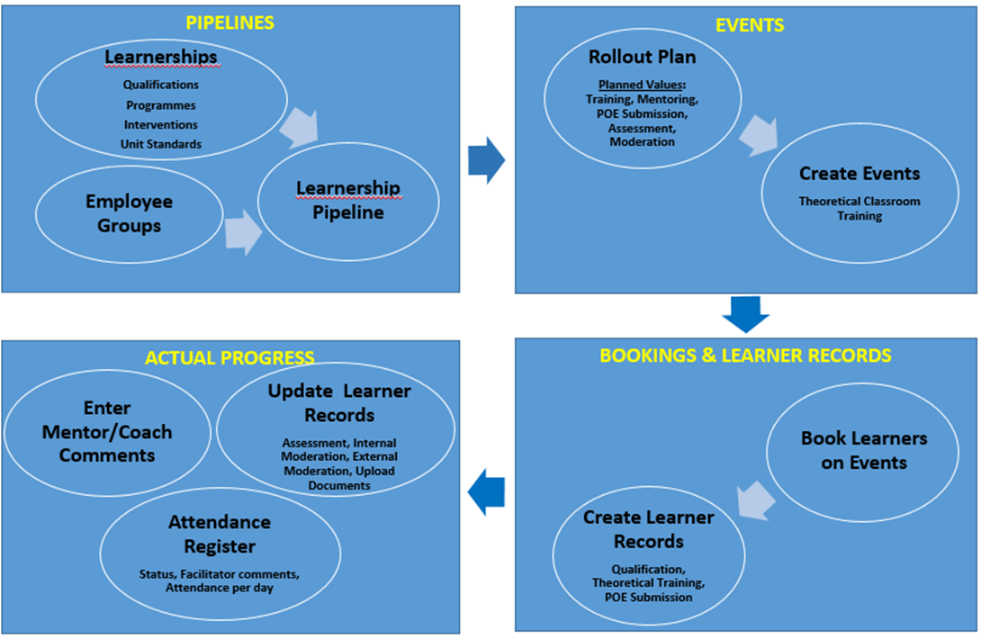The Advantages of LMS Learnership for Upskilling and Reskilling Employees
The Advantages of LMS Learnership for Upskilling and Reskilling Employees
Blog Article
Strategic Execution of LMS Learnership Programs for Sustainable Staff Member Growth
In the realm of labor force development, the strategic implementation of Discovering Monitoring System (LMS) learnership programs stands as a linchpin for cultivating sustainable employee development within companies. By diving into the intricacies of creating and executing LMS learnership programs with a strategic lens, organizations can unlock a myriad of benefits that not only improve worker capacities yet likewise contribute to the overall sustainability and success of the company.
Benefits of LMS Learnership Programs
LMS learnership programs use a wide range of benefits for both employees and organizations looking for continual professional growth. One of the vital advantages is the versatility they give in regards to discovering pace and availability. Workers can involve with the discovering material at their own benefit, enabling them to balance their instructional quests with their job duties efficiently. In addition, these programs often use a large range of courses and resources, enabling workers to get new skills and knowledge pertinent to their functions or profession goals.
Furthermore, LMS learnership programs promote a society of continuous understanding within organizations. By motivating employees to upskill and stay upgraded on industry trends, business can enhance their general competitiveness and development capacities. This concentrate on learning and development additionally improves staff member spirits and engagement, leading to greater retention prices and boosted job contentment. On the whole, the advantages of LMS learnership programs extend beyond private growth to incorporate the holistic development of both employees and the companies they offer.

Trick Techniques for Implementation
Building upon the foundational benefits highlighted earlier, efficient execution of learnership programs needs critical preparation and implementation to maximize their influence on worker advancement and organizational growth. One vital technique for successful execution is straightening the learnership program with the organization's general goals and goals. By ensuring that the program's web content and framework are in sync with the firm's critical direction, workers are most likely to see the importance of their participation and exactly how it contributes to the bigger photo.
Leadership support not only gives the needed sources and funding yet also sends out a message to employees concerning the program's relevance. Additionally, developing a robust communication plan that details the program's structure, benefits, and assumptions helps in taking care of participant and stakeholder assumptions, fostering involvement, and maintaining transparency throughout the application procedure.
Measuring Program Efficiency
Effective dimension of the learnership program's effect is essential for evaluating its total performance in boosting staff member advancement and adding to business growth. To determine program performance, vital performance signs (KPIs) need to be established. These KPIs must align with the program's purposes and the company's tactical objectives. Typical KPIs for determining the effectiveness of learnership programs consist of employee involvement levels, knowledge retention prices, skills enhancement, and performance improvements. Studies, analyses, and feedback mechanisms can be made use of click for info to collect measurable and qualitative data on these KPIs.

Overcoming Execution Challenges
To make sure the effective implementation of learnership programs and optimize their effect on employee development, companies need to resolve and conquer different challenges that might emerge throughout the execution phase. One common challenge dealt with is resistance from employees that might be reluctant to take part in brand-new learning efforts. This can be mitigated with clear communication regarding the advantages of the program and dealing with any kind of worries elevated by personnel.
One more obstacle is the absence of sources, both in regards to budget restrictions and time restrictions. Organizations can conquer this by prioritizing the allotment of sources towards the learnership program and seeking external financing or partnerships to sustain its execution.
Additionally, guaranteeing energetic participation and interaction from both staff members and administration is vital for the success of the program. This can be achieved through developing clear objectives and assumptions, offering recurring assistance and comments, and identifying and awarding achievements. By proactively addressing these application difficulties, organizations can improve the performance and sustainability of their learnership programs for worker development.
Making Sure Long-Term Sustainability
Protecting the longevity of staff member advancement campaigns calls for strategic planning and continual adjustment to evolving organizational requirements and external elements. To ensure Home Page the long-term sustainability of LMS learnership programs, organizations must prioritize several key facets. To start with, it is necessary to regularly examine the click reference efficiency of the program with performance metrics, participant responses, and alignment with company objectives. This analysis enables the identification of areas for improvement and modification to make certain the program continues to be relevant and impactful.
Additionally, promoting a culture of finding out within the organization is important for sustaining worker growth campaigns. Encouraging constant understanding and professional growth not just advantages private employees but likewise adds to the overall flexibility and competitiveness of the company. Integrating the learnership program right into the company's long-lasting critical planning makes certain that it gets the essential sources, buy-in from leadership, and placement with the company's future instructions. By taking a positive and holistic technique to the sustainability of LMS learnership programs, organizations can cultivate a skilled and dexterous labor force capable of fulfilling the obstacles of tomorrow - lms learnership.
Verdict
To conclude, the critical implementation of LMS learnership programs is crucial for sustainable employee advancement. By concentrating on advantages, vital techniques, gauging efficiency, conquering difficulties, and ensuring long-term sustainability, organizations can develop a structured technique to sustain continuous discovering and development. This approach makes it possible for employees to improve their abilities and knowledge, eventually resulting in boosted efficiency and performance within the organization.
Report this page